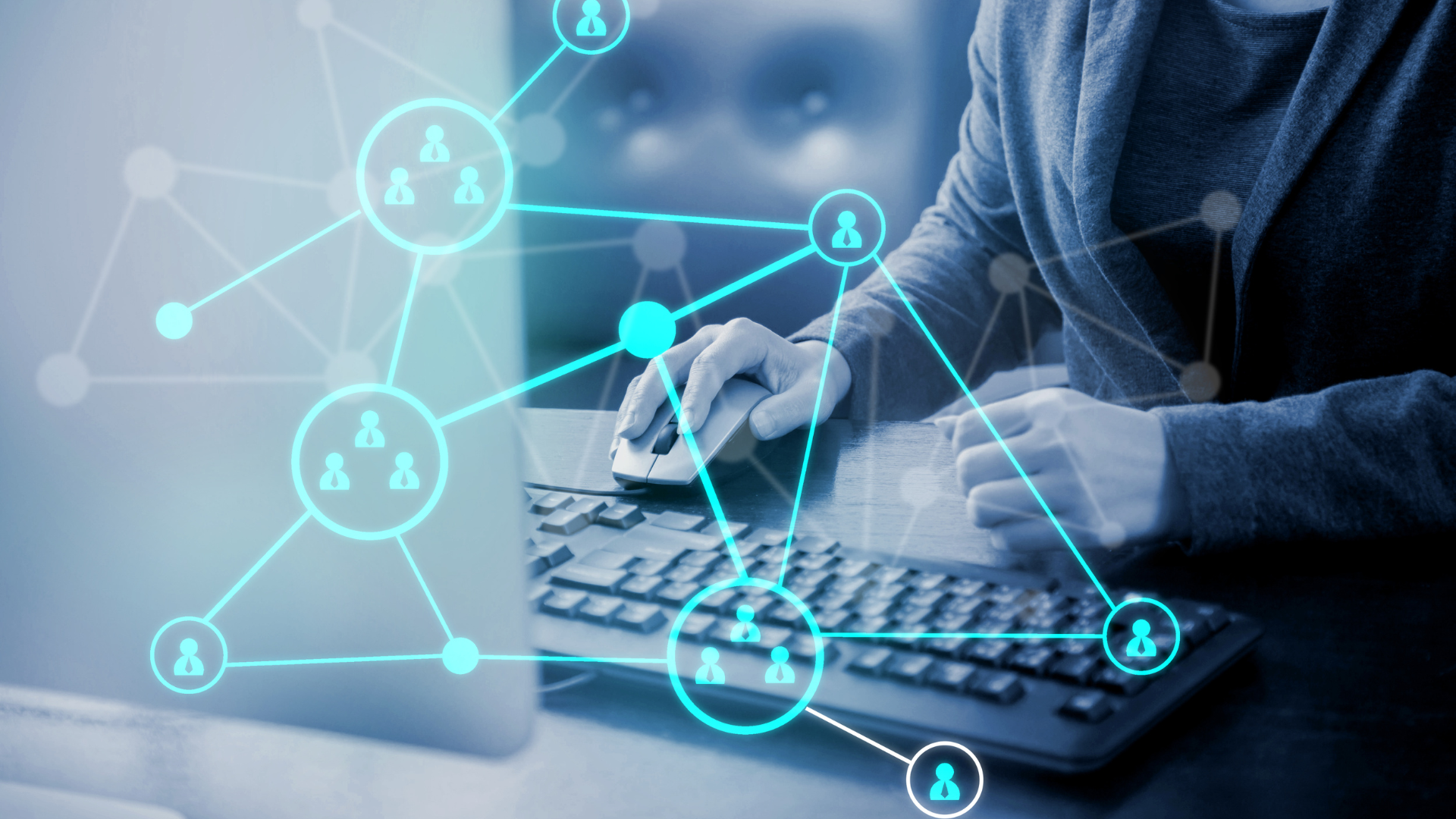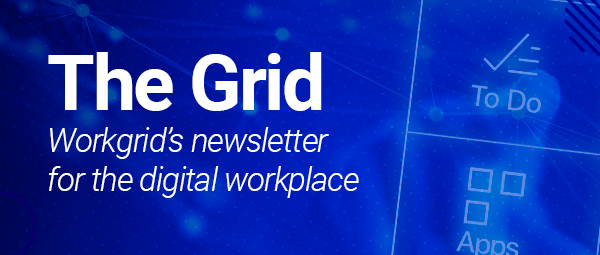Artificial Intelligence (AI) is the talk of the town, and for good reason. Over the last few years digital transformation has taken workplaces by storm, and the AI revolution is no exception. Many organizations are integrating AI-powered tools into their digital workplace, allowing teams to work smarter, faster, and more efficiently as AI helps reduce the burden of digital friction. Here’s a look at just a few of the benefits of bringing this technology into your digital workplace.
Improved Productivity
With the help of artificial intelligence organizations can improve productivity among their workforce in a variety of different ways. Perhaps the most prominent however is the automation of repetitive tasks.
Take for example something as simple as reminding employees to complete a training or disseminating information such as weekly reporting. By automating these sorts of habitual tasks, employees have more time to focus on high-value projects. Perhaps without being bogged down by managing the training reminders, that same employee can now spend their time curating more learning management courses and programs for the betterment of the organization.
In addition to automation, here are other common ways AI can support digital workplace productivity:
Summarization - help structure thoughts and ideas by summarizing information or content such as meeting notes or email drafts
Translation - quickly and easily translate written content
Sentiment Analysis - consolidate sentiment on content and surface in a digestible format
Reducing Context Switching with AI
It’s a common misconception that AI-powered tools will replace human responsibilities to improve productivity. While this may be true in some capacities, there are many degrees in which this technology can support the workplace. Leveraging AI technology in the form of nudgetech and integrations creates more simplified experiences that can have a huge impact on productivity by reducing context switching to help employees focus.
Context switching, or the act of toggling between apps and windows, has widely been accepted as “the way we work” but has ramifications for employees. Not only is it cognitively taxing and limits focus, but it is also time-consuming. According to a study done by the Harvard Business Review, the average employee context switches nearly 1,200 times a day. With the time for each switch being about two seconds, this adds up to five working weeks over the course of a year. Using AI-powered tools to integrate with workplace systems can help reduce this wasted time by elevating tasks and information out of the source system and delivering it directly to employees within the flow of work.
Increased Efficiency
A rising sentiment around artificial intelligence is the argument that “the robots are coming to take our jobs.” Realistically, jobs will change. Some jobs will be made redundant, while some will be created. But with the introduction of AI, we also can expect to see increased efficiency.
If we look back 20 or 30 years for example, technology at work was completely different. It was a time when it could take hours scanning through textbooks to answer one question. As technology evolved with the invention of search engines like Google, those processes shrunk from hours to minutes. Now, as we evolve again, we can expect similarly transformative behavior. Perhaps AI takes this one step further and not only can you find the answer to your question, but the output will also summarize it in a concise manner or intelligently anticipate your question before you even ask it.
An increase in knowledge sharing led by AI is likely to result in reduced bottlenecks in workflows as intelligent technologies streamline processes and the flow of information. With the support of AI-led experiences, managers can more quickly complete tasks like approvals or receive reminders, generate content, and find answers to questions.
With different types of AI available, here’s a look at how they each can help improve efficiency.
Generative AI
With the support of generative AI, content creators can deliver creative and engaging content quickly and efficiently. This type of AI can expedite processes by helping to structure content like blogs, emails, or presentations. While humans are still required to assemble and strategize, the content model can help outline and fill in the gaps much faster, so employees can move onto the next task.
Conversational AI
Conversational AI is a form of intelligence that can simulate human conversation. With the support of conversational AI in the digital workplace, organizations can help ensure that employees are able to access and find the information they need in the form of a chatbot. Using natural language processing, employees can prompt the chatbot with a wide range of queries in which it will return a myriad of responses including apps and systems, frequently visited links, documents, FAQ answers, and more. Conversational interfaces can connect to different types of information, whether it be directly through systems, documents, or through third-party knowledge repositories with the use of APIs. Adopting conversational AI into the digital workplace is a clear path toward increased efficiency with employees able to find information and act faster, removing barriers of digital friction and providing a single source of truth.
![[asset] content-genie-details](https://images.ctfassets.net/z7p73u8c0thn/1npCn2ZDcTIkELp3b37c4L/7a950418564097d8676bf72b91b14702/content-genie-detail-image.png?w=1200&h=1064&q=60&fm=png&bg=transparent)
Enhanced Accuracy
It’s no secret that teams have been struggling across a series of challenges. From navigating rapid digital transformation because of the pandemic, to simply fighting for employees’ attention among all the technology at work.
AI-powered algorithms help navigate digital friction by harnessing AI technology in helpful ways – think intelligent automations, alerts, and detections, to help improve accuracy among the digital workplace. We can expect to see an increase in AI agents that are chatbots using a large language model – bringing together the conversational interface and the LLM to make decisions and perform actions. As a result, we are likely to see more interactions with third-party systems, which means these types of AI assistants can do even more for the employee. From AI-powered algorithms that moderate content or scan for personally identifiable information to request submissions or reading recommendations, bringing together systems and AI will provide employees with more intelligent and useful information.
Reduced Cost
One of the most prominent benefits of integrating AI into an enterprise tech stack is the reduced cost. It is widely recognized that AI can help reduce labor costs by reducing the need for human intervention. This doesn’t necessarily mean the reduction of jobs, but rather tools that allow for humans to prioritize their energy on more robust tasks. Examples of this include using a chat to find information instead of contacting a support representative, integrating systems within a digital assistant to help manage incident management, or automating timesheet and travel reminders to reduce time taken up by administrative tasks.
Improved Employee Satisfaction
Surfacing answers to frequently asked questions and 24/7 support are just a few ways conversational AI can help improve employee satisfaction. In addition to knowledge management, AI can surface nudges and reminders that elevate information employees need and want to know – from time off balances and job postings to trainings, performance review reminders, and even sentiment analysis and content performance insights – making sure employees never miss a thing.
While AI brings numerous benefits to the workplace, it is crucial to approach its adoption with careful planning and consideration. To fully leverage the power of AI, organizations must invest in robust infrastructure, data security measures, and employee training to ensure a smooth transition and successful implementation.
Delivering AI-powered tools can have a significant impact on overall employee experience but can be costly and time-consuming to implement. Workgrid’s AI Assistant helps eliminate the time to integrate and launch AI-experiences within the digital workplace with a catalog of ready-to-use app templates. Product owners and IT managers alike can leverage Workgrid to level up experiences with an organization’s existing tech stack, and quickly launch apps to support teams across departments and business lines.
Learn more about Workgrid’s templates.




